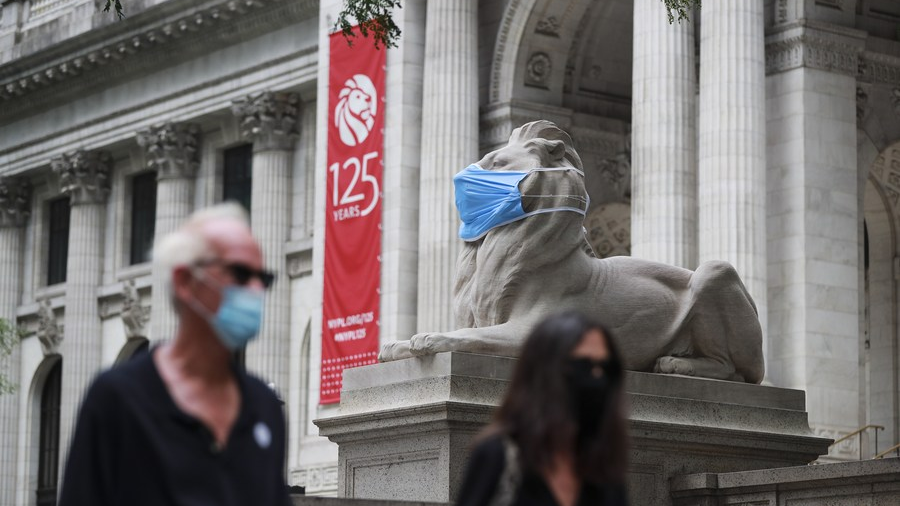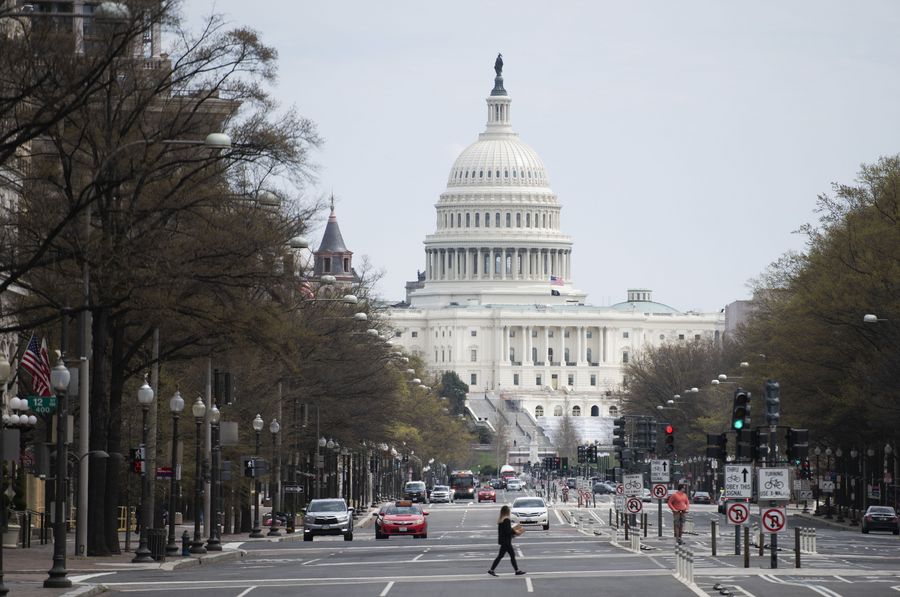
A marble lion is seen with a face mask in front of the New York Pubulic Library on the Fifth Avenue in New York, the United States, July 8, 2020. /Xinhua
A marble lion is seen with a face mask in front of the New York Pubulic Library on the Fifth Avenue in New York, the United States, July 8, 2020. /Xinhua
Editor's note: Sun Chenghao is an assistant research professor at the Institute of American Studies, under the China Institutes of Contemporary International Relations based in Beijing. The article reflects the author's opinion, and not necessarily the views of CGTN.
Among many problems in American society today, the expanding wealth gap is particularly prominent. The economic inequality will even define the 2020 U.S. presidential election. Against the backdrop of the COVID-19 pandemic and racial discrimination aroused by Floyd's death, the structural gap between the rich and the poor, a deep-rooted illness in American society, has once again emerged.
The U.S. has witnessed the phenomenon that the rich are getting richer and the poor are getting poorer, despite the economic expansion and massive tax cuts.
According to U.S. Census Bureau data, in 2018, households in the top fifth of earners brought in 52 percent of all U.S. income, more than the lower four-fifths combined. In 1968, by comparison, the top-earning 20 percent of households brought in 43 percent of the nation's income.
Moreover, data from the Organization for Economic Cooperation and Development show that the wealth gap in U.S. is the most prominent among G7. In 2018, the Gini coefficient of U.S. was 0.49, while the other six countries were lower.
The historic shrinkage of the U.S. middle class can better showcase the problem. For more than four decades, the U.S. has been the olive-shaped income structure where the middle class has played a central role, but according to the Pew Research Center, the structure broke the tipping point in early 2015 when the number of people in the middle class decreased to about 120.8 million, while the total number of the rest reached about 121.3 million. In other words, this olive-shaped income structure has been transformed and moved towards the direction of a bucket-shaped one.

The U.S. Capitol building in Washington D.C., the United States, March 27, 2020. /Xinhua
The U.S. Capitol building in Washington D.C., the United States, March 27, 2020. /Xinhua
Two specific dimensions of the wealth gap in U.S. are extremely pronounced.
First, there is a significant geographic gap between rich and poor. According to a report by the Economic Innovation Group, the more economically disadvantaged population gather in only 80 cities in the Northeast and Midwest including the Rust Belt, with multiple losses of population, jobs and business opportunities. In contrast, the most prosperous cities are concentrated in a number of technology hubs and emerging places in the likes of California and Texas. The prosperity gap between regions is also widening.
Second, the generational gap between rich and poor cannot be ignored. Although the growth of the American middle class has been stagnant since the 1970s, one phenomenon has persisted that the younger generation will always outperform the elder one.
But in terms of income, roughly since 2009 with the beginning of the Obama administration after the financial crisis, this trend has changed dramatically. The younger generation, with higher levels of education, are now even less well-off than their parents, creating feelings of frustration and dissatisfaction.
The root of the wealth gap in the U.S. lies in the economic model and social policies of the capitalist system.
Economic growth under capitalism inevitably leads to a growing disparity in wealth between Americans who rely on capital to earn money and those on labor. As the occupiers of capital are in a dominant position, it ultimately leads to the emergence of the wealth gap. Meanwhile, neo-liberal policies pursued by the U.S. government by adhering to the "market omnipotence theory" further exacerbated the wealth gap. The proper role of the U.S. government in secondary distribution is ignored, and its ability to correct market misallocation is weaker than in other Western countries.
For the majority of those who are about to lose or have lost their middle class status, the widening wealth gap has become too much for them to bear. People are disenchanted with the so-called moderate recovery of the U.S. economy, disillusioned with current living standards and social realities, full of anger at ineffective politics and suspicion of the traditional politicians in Washington. Divisions across different income groups have fueled political polarization, partisan rifts and ethnic conflicts, providing the perfect environment for social chaos and disruption. It turns out that almost four years into the Trump administration, the problem of wealth gap based on systemic problems still has not resolved.
(If you want to contribute and have specific expertise, please contact us at opinions@cgtn.com.)